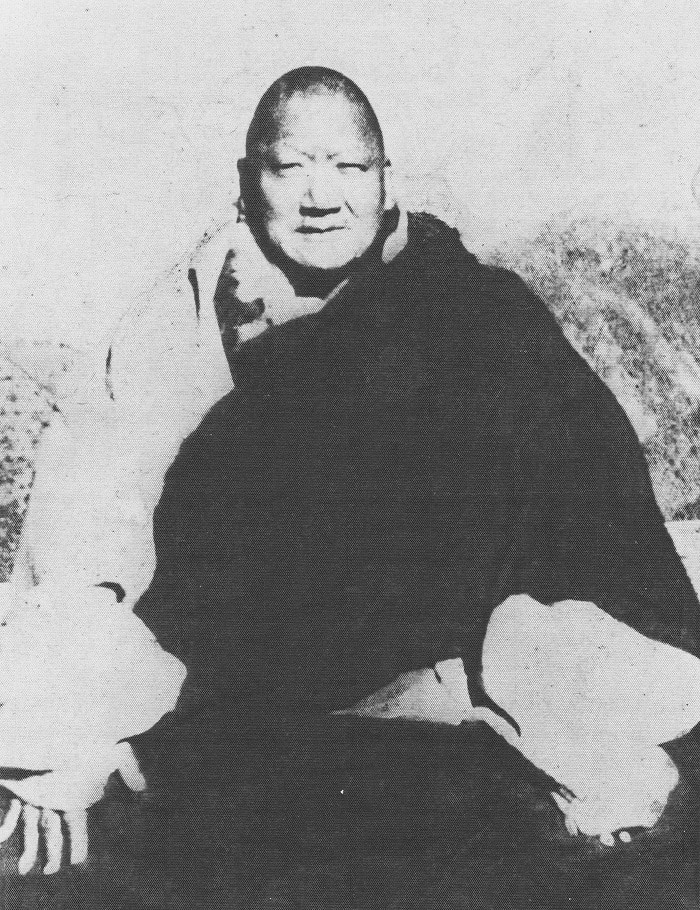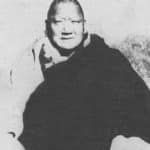
In one of his seminars, Trungpa Rinpoche talked about his experiences with his root guru Jamgön Kongtrül of Sechen:

When my root guru first came to our monastery, I was nine years old. The day before he arrived, it was decided that my head was to be shaved again, which is an excruciating experience. The razor was somewhat dull, there wasn’t enough soap, and in place of shaving lotion, the sulfur deposit from hot mineral springs was used. Whenever I complained, I was told that if I want to meet this great teacher, I better just endure it, and that half of my head is already shaved anyway, so the rest of the job better be completed. After having gone through that ordeal, I felt a sense of relief and expectation for the next day.
In the traditional welcoming ceremony, I was the one who had to precede him with the incense stick to lead him to the place where he was to stay. The first glimpse of him was of a kindly old monk, nothing extraordinary about him particularly, except that he seemed to find everything that he saw very funny. He kept on laughing and making little jokes about this and that, commenting about the doorways and his seat and the musicians.
The situation was very simple. He sat down in his seat in a somewhat sloppy way that one wouldn’t expect of a great teacher. I had been taught that a great teacher would be extraordinarily refined, so Jamgön Kongtrül’s spontaneity and sloppiness called forth in me a sense of kinship with him because my tutors constantly accused me of being sloppy myself, giving me examples of the tenth Trungpa’s style. So I felt somewhat relieved and almost expected them to correct his actions as they used to do mine, but they accepted them and in fact began to appreciate them. I felt that they had kept hidden from me this new area of wisdom that is actually possible if a person is disciplined and well trained. This was my first glimpse of crazy wisdom.
I was very attracted to this person who for the first time showed me that my own style was okay. I myself could be spontaneous, and a holy man could be very human rather than superhuman or divine, an understanding that in my experience had been rejected in the past.
Several extraordinary things about Jamgön Kongtrül of Sechen were that occasionally he would stop conversing as though he didn’t care for anything in particular or as though he were completely open, and then after a while he would continue. Also, although he was supposed to be very near-sighted and when reading a letter had to hold it up very close to his eyes, yet sometimes he would spot people miles away. It was somewhat confusing; he somehow did not fit into the social norm expected of a great guru. His spontaneity caused my tutor and bursar, who usually presented themselves to me as being well prepared and imperturbable, to become embarrassed and bewildered, which was a new experience for me.
The first problem that I came across was to understand Jamgön Kongtrül dialect. I worked very hard, not having a translator at the time, and within about two weeks, I could speak his dialect. Jamgön Kongtrül found it very funny that his own monks were very pleased at this but that my tutor and bursar were somewhat worried that I would become a frivolous actor, imitating everything. In fact, I was able to translate for them when he talked.
Jamgön Kongtrül decided to stay for a while at Dorje Khyung Dzong, the retreat center at which the fourth Trungpa had meditated. This was the occasion for me to receive my first instruction in meditation, which was very simple. I came at about seven o’clock in the morning, presented the traditional gifts, and sat down, feeling very inquisitive about it and thinking that it would make me Buddha on the spot or that something might come through. As I sat in front of him, the first sunbeams shone through the latticework of the window. He began to talk about mind, and he asked me, “Do you have a mind?” I answered, “Well, I think so many things; therefore, I must have a mind.” He had a good laugh at that. Then he said, “Let’s sit together and do nothing for a few seconds,” which we did. I expected something extraordinary to happen, like suddenly seeing some great vision, but nothing happened, and he was very pleased. I was confused, not understanding why he was pleased that nothing actually had happened. He told me not to talk about it to any of his people or to my tutors, but I wasn’t sure what not to tell, as there was nothing to talk about. Therefore, when I went back to my room, I tried to visualize the whole process, the conversation, the atmosphere, the sun shining through the tinted windows, its beams striking the floor, his face, his posture, his smile, and his sudden excitement. But I couldn’t understand exactly what had happened, and as I had heard that one is supposed to have great faith and conviction, I felt that maybe I was lacking in faith and conviction.
During my second meeting with him to review what development had taken place, he asked me what had happened at our first meeting. I said, “Actually, nothing happened. I can’t see what it’s all about.” He said, “Let’s sit together again.” We sat together again and exactly the same thing happened—nothing happened, but something did happen. Maybe it was just my visual perception of the room, its light, or the sun shining through. The whole atmosphere of the room was very light. Traces of incense could be smelled. When I sat on the cushion next to him, everything smelled very fresh and felt very light. Then he began to instruct me in the shamatha-vipashyana practice of watching the breath. That was a great help because then something actually happens simultaneously with nothing happening, and I found that I was able to re-create that feeling.
I met with him again after he moved back from the retreat center to the monastery. I was very excited and wanted to show him what I experienced. He was pleased when he watched me and told me to go ahead but not tell anyone about it. Then I asked him, “What about enlightenment?” By this time I felt more relaxed with him, and he too was very light and open and delightful, making puns and jokes, constantly joyful with occasional silliness, which I found quite thrilling. He answered, “There is no such thing as enlightenment. This is it.” I was bewildered and then asked, “If that’s so, do I still have to study with my tutor and have all that hassle?” He became very sad, almost in tears, and said, “Don’t worry. Everything will be okay. Come and visit me in my monastery four years from now.”
Many students from my monastery had personal meditation interviews with Jamgön Kongtrül. Some of them thought they were having mahamudra experiences, and he would recommend that they return to their breath, a suggestion that offended some of them who thought that they were being told to revert to a more primitive level. But others were delighted with the correction, having been uncertain of what they were doing. The atmosphere created by Jamgön Kongtrül was so solid and so definite that one had simply to tune into that atmosphere. I remember feeling that atmosphere all the time. When one was approaching his residence, one felt some kind of radiation, and when one came closer, the atmosphere became more and more dense so that when one opened the door into his rooms, there was a feeling of uncertainty, fear, but at the same time, a feeling in the bottom of one’s heart somewhat of being tickled: pain and pleasure together, sweet and sour at once. Meeting with other teachers did not really tickle the heart. Being with him brought a strong sense of energy and reality, an experience that was by no means a dream, but very much alive.
When I was older, I would make up lists of questions to ask him during our interviews, but as soon as I would look at the list, the questions seemed completely absurd and made no sense at all. Toward the end of my stay with Jamgön Kongtrül, he would usually check on how my studies with Khenpo Gangshar were going: how much I understood in terms of scholarship, philosophy, and facts and figures, and what I understood on the intuitive level.
Later, I began to take fewer notes but to write some six-syllable poetry that I would give to him when I visited him, which he carefully corrected. Later, I would just scribble something down, and there were fewer corrections. I thought that he was getting bored with all my poems, but actually he read them all. He said, “If you write with an intention, it doesn’t work. You have to write without intention.” We had a three-hour session together in which he would write one line, and I would write the next line. When he read though the three pages we had written together, it sounded like his own writing, not mine. This was not particularly helpful to me as it was too much of an ego boost. I began to write a lot of poetry, writing formal poems instead of letters. I felt that I was becoming too literate, too good at mimicking, but Jamgön Kongtrül did not discourage me. He began to introduce me to great poets or scholars who visited him, and I would be asked to write a poem on the spot, which made me feel that I was somewhat of a showpiece. At that time, I began to write dohas and various short sadhanas. I slowly developed a sense of vajra pride in expressing myself, that in essence everything was okay and that Jamgön Kongtrül’s approval was not the main point. One particular sadhana that I wrote, he said, influenced him so much that he was still high on it the next day, a remark that I was uncertain whether to interpret as sarcastic or real.
Now, Jamgön Kongtrül began to generate moments of black cloud permeating the atmosphere, particularly after he had witnessed a logical debate in the seminary at which I was a brilliant student, a young smart kid overcoming everybody’s arguments. I expected some sort of reward when I later walked into Jamgön Kongtrül’s room, but it was dark. I could just make out his silhouette and hear the crack of his mala beads. I sat down. Nothing happened. He said nothing for about forty-five minutes. His attendants brought in his food and tea, and I could hear the crack of his jaws in their sockets as he chewed his meat, a very threatening sound. The situation became very intense. Before I left, he spoke a few words, “Watch your step. You could become a brilliant logician. But there is no warfare happening in this country, and there is no such job for that sort of person. Think about it.” After that, I began to work more on the experiential rather than on the purely logical level of the abhidharma and Madhyamaka.
Immediately after that, for a period of about fifteen days, Jamgön Kongtrül was particularly critical, and everyone was very frightened of him. The atmosphere was a black cloud. He beat the abbot of Sechen with his solid bamboo walking stick and kicked him. His cook and his old tutor were very frightened. In those days I used to exercise by walking toward and away from his house. I could feel the change in the atmosphere, like a change in temperature.
At the end of the summer, Jamgön Kongtrül decided to take all the young tülkus and young scholars on a vacation, and he told the tutors that they were not allowed to come. We collected whatever people could contribute—a pound of butter, a bag of rice, a brick of tea, or a leg of lamb—and we camped in a tent in a big field beyond Sechen monastery at the junction of two rivers. We played all kinds of games and had a big feast. Everyone felt free because there was nobody watching. Jamgön Kongtrül himself completely changed his personality so that one forgot what had happened in the previous several weeks. This was a most powerful experience for me. To be without a watcher, your tutor or your own watcher, was an enormously powerful and delightful experience. You get a better sleep and wake up with delight.
In the relationship with my guru, it became very obvious that the world is extraordinarily clear and precise, not purely speculative, but having soft edges, a real world that happens. And a lineage holder—a complete, thorough, one hundred percent lineage holder—manifests a world of a particular nature, which becomes very evident. Within that world there is a general sense of sanity, where one’s neurosis is workable.
From The Collected Works of Chögyam Trungpa, Volume Nine © 2017 by Diana J. Mukpo. Introduction to Volume Nine © 2017 by Carolyn Rose Gimian. Reprinted in arrangement with Shambhala Publications, Inc. Boulder, CO. www.shambhala.com






